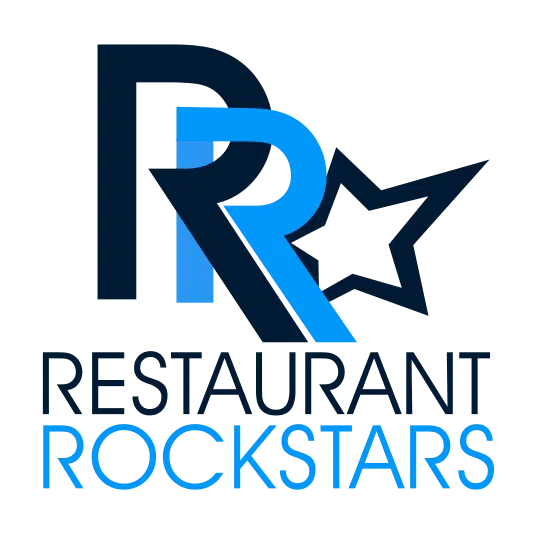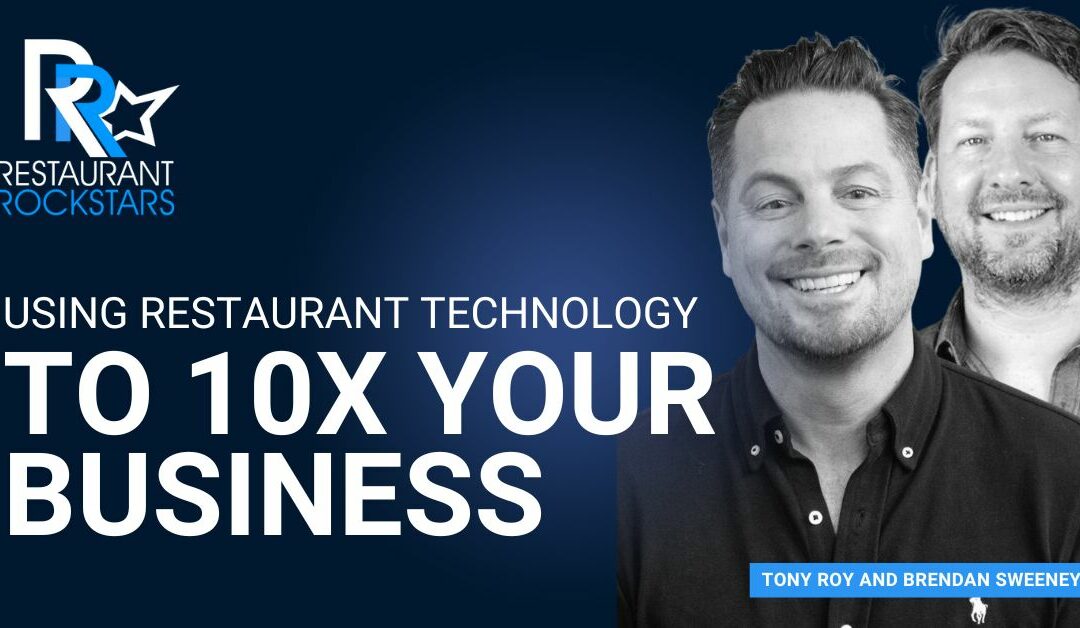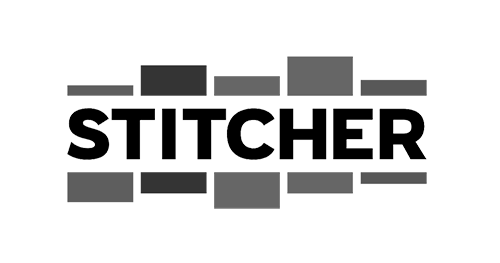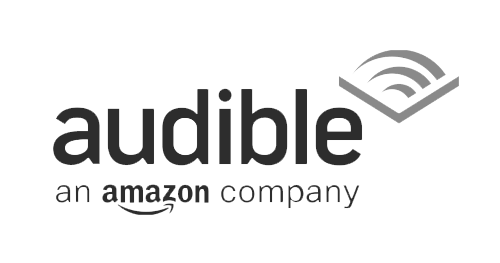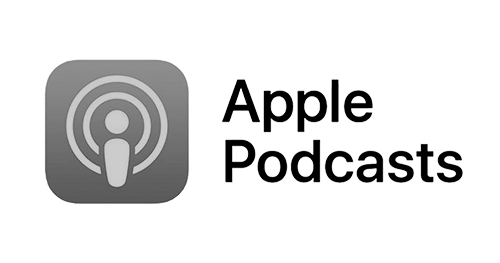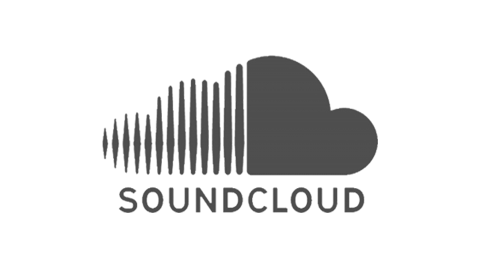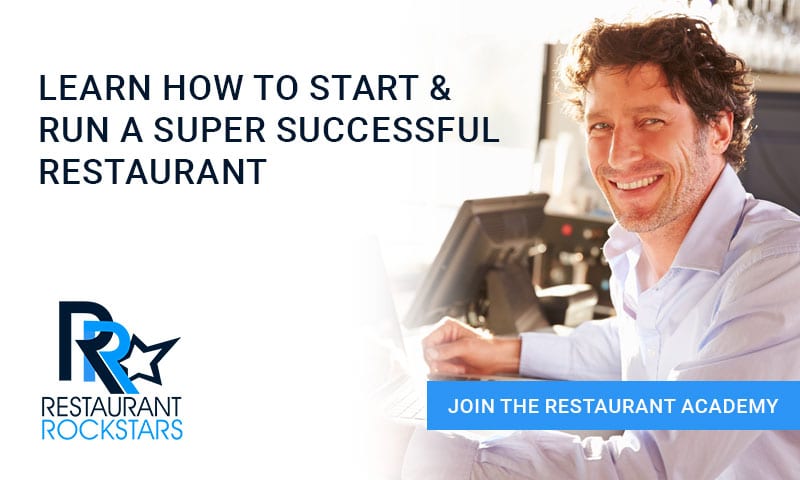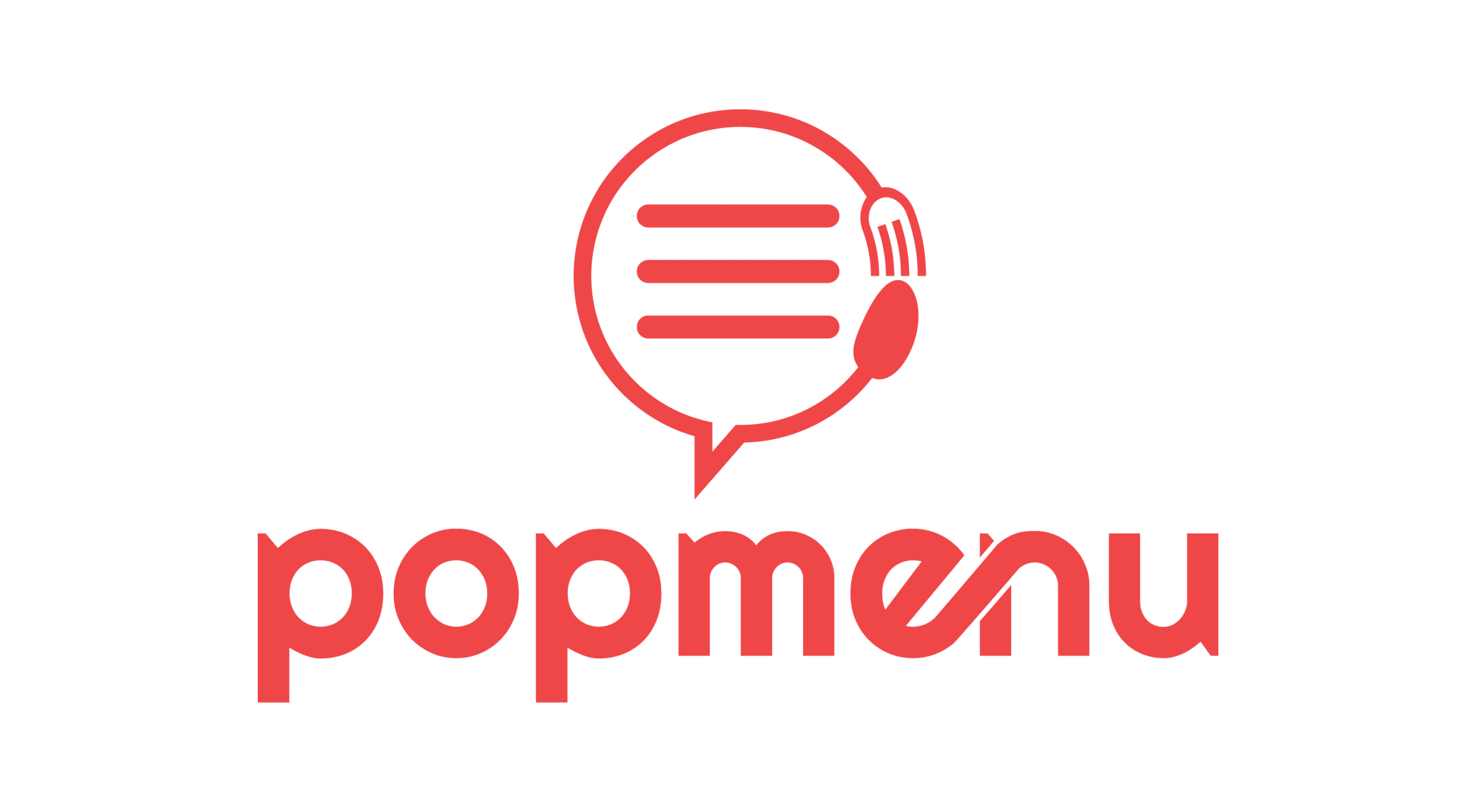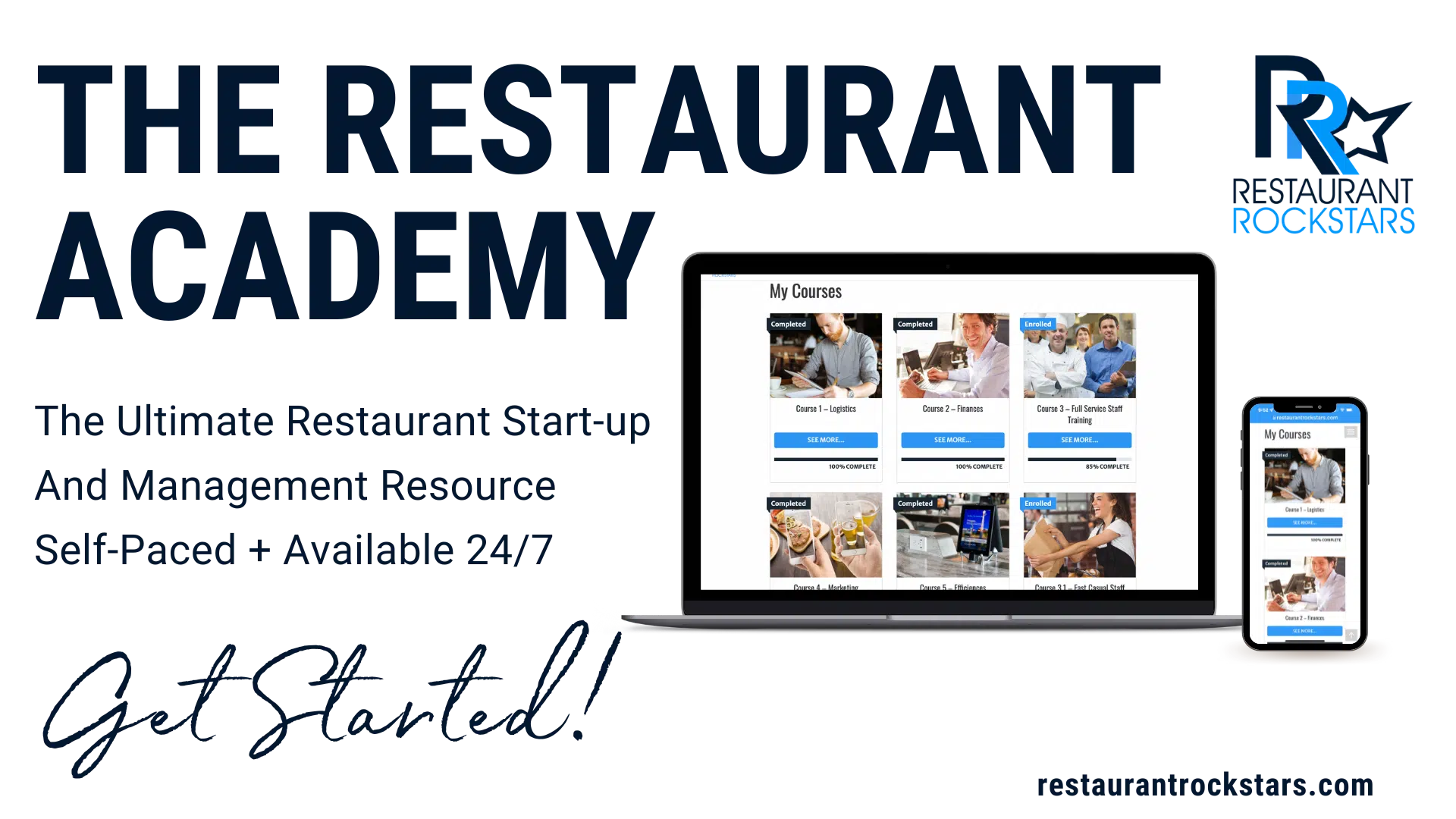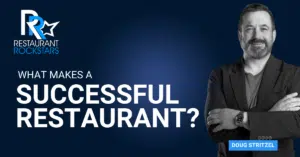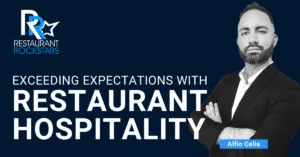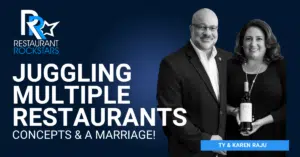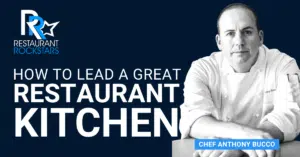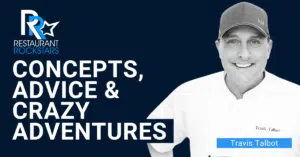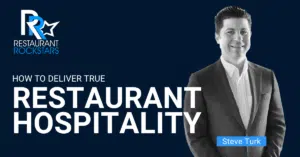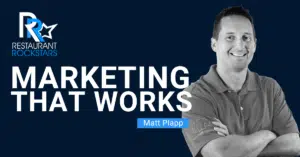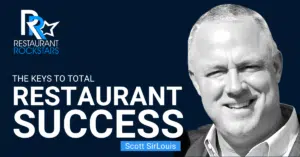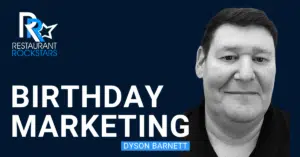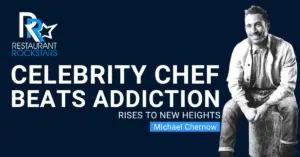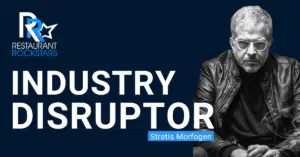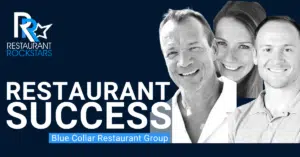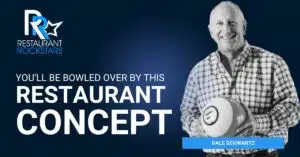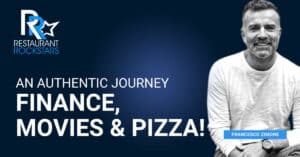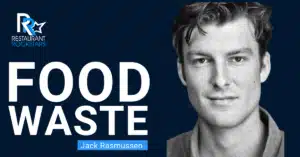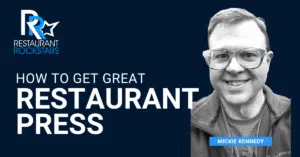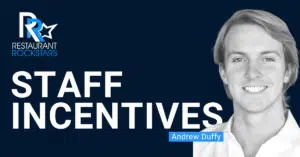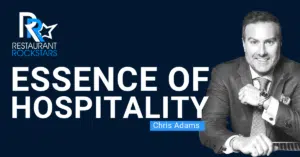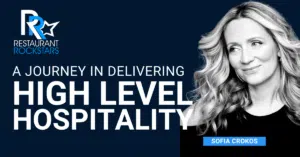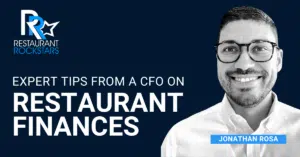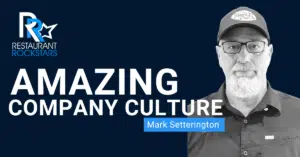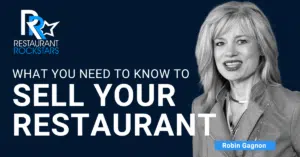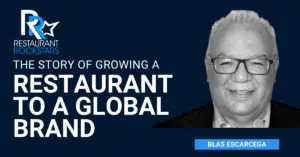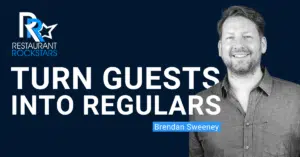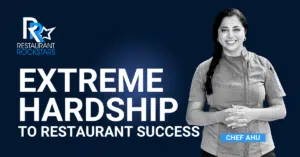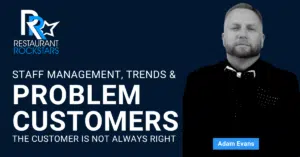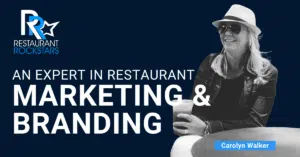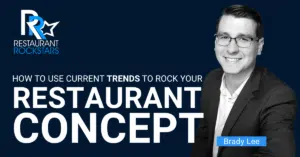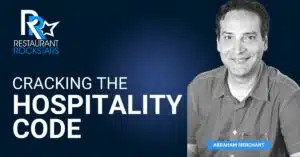Restaurant Rockstars Episode 375
Using Restaurant Technology to 10X your Business
LISTEN HERE OR ON YOUR FAVORITE PODCAST PLAYER
As a restaurateur, you can’t afford to ignore restaurant technology.
Since the pandemic, operators of every size have had to adapt to platforms and tools that offer guest convenience and operating efficiencies. The landscape keeps changing every day and to stay competitive, great food and service are no longer enough to keep guests coming in the door.
In this episode of the Restaurant Rockstars Podcast, I’m speaking with Brendan Sweeney and Tony Roy who run Popmenu, arguably one of the leading and fastest growing restaurant technology companies.
We delve into the innovative ways PopMenu harnesses the power of artificial intelligence for answering phones, increasing customer interactions, enhancing menu engagements and marketing strategies.
We also discuss how adopting such technologies can significantly increase restaurant profitability and improve operations, amid labor shortages and other challenges faced in the industry.
Listen as Brendan and Tony discuss restaurant technology including:
- What’s important to know about current and future restaurant technology.
- Guest expectations in today’s dining or “to go” experiences.
- How to get more customers, increase their frequency and boost your restaurant margins
- The basics of Artificial Intelligence and why it’s the future of your restaurant operation
- How your restaurant can benefit from 10 million plus data points on guest preferences
- How to uplevel guest service and free staff time from answering your phone while still informing guests calling in.
Brendan and Tony also highlight Popmenu’s exciting new partnership with Open Table and what’s coming next.
Don’t miss this episode, get my FREE “Top 3 Ways You’re Killing Your Restaurant Profits and a bonus at www.restaurantrockstars.com/profits then go out there and Rock YOUR Restaurant!
Roger
Connect with our guest:
Facebook: https://www.facebook.com/popmenu/
Instagram: https://www.instagram.com/popmenu
LinkedIn: https://www.linkedin.com/company/popmenu
Twitter/X: https://twitter.com/GetPopmenu
Welcome back to the Restaurant Rockstars podcast. , our mission is all about helping restaurants increase profitability, and just run a stronger operation. So this week’s guests, no exception. I’m speaking with Brendan Sweeney and Tony Roy from. Arguably, one of America’s fastest growing and hottest restaurant technology companies out there, I’m talking about PopMenu.
Now, they’re all about getting more customers in your door, increasing frequency, increasing margins, and now they’re specializing in artificial intelligence, identifying 10 million plus restaurant data points on guest preferences, not to mention their phone. answering platform that has answered 3.1 million calls for restaurants.
Obviously, the labor shortage has decreased staff and, , that’s just one less thing you have to worry about is answering the phone. So, you gotta check out this episode. Again, it’s all about game improvement technology. Thanks so much to the sponsors this week, and if you haven’t already, head on over to restaurantrockstars.com/profits. I’m giving away three ways you’re killing your restaurant profits and a special bonus restaurant assessment, either for full serve operations or quick serve. It’s seriously thought provoking questions that Analyze all aspects of your operations. That’s going to help your bottom line and help you run a more profitable restaurant.
So check it out now on with the episode.
You’re tuned in to the Restaurant Rockstars Podcast. Powerful ideas to rock your restaurant. Here’s your host, Roger Beaudoin.
Rockstars, this year, give your team the gift of PopMenu AI Answering, a simple solution for phones ringing off the hook. AI Answering handles calls 24/7, 365 days a year, so your staff can focus on in person guests.
Customize your greetings and responses. Answer common questions. promote specials and events, and send follow up links to ordering and reservations. AI answering handles it all, while escalating more complex conversations back to your team. Now, never miss another tasty revenue opportunity. PopMenu is the marketing technology platform designed to make growing your restaurant easy.
Discover more A. I. restaurant tools that turn your to do list into an already done list. Request a demo today and my listeners for a limited time will get $100 off their first month, plus lock in one unchanging monthly rate. Go now to popmenu.com/rockstars. Again, get $100 off your first month at popmenu.com/rockstars.
Running a restaurant is a marathon of management. You’re constantly managing customers, employees, vendors, menus, marketing, and the list goes on. But don’t forget the essential element, managing inventory, a crucial factor that can make or break your success. Listen, Sculpture Hospitality is the secret ingredient you’ve been missing.
They don’t just manage your food and beverage inventory, they blend expertise with technology. They take your inventory, sales, purchases, everything, and transform it into a roadmap for your restaurant’s success, painting a vivid picture of your profitability. Their range of service options will meet your needs and your budget.
Are you looking for a hands on, full service solution using one of their inventory experts? Or do you prefer sharing inventory responsibilities? Or even a self service option? Well, Sculpture Hospitality Services are like a customized menu. Take charge of your bar or restaurant inventory today. Get a free, no obligation, inventory consultation from Sculpture Hospitality.
Visit SculptureHospitality.com/rockstar and discover their inventory solution that matches your needs, your budget, and your success.
Welcome back everyone. This is the Restaurant Rockstars podcast. Brendan, Tony, welcome to the show today. How are you guys? Doing great, Roger. Thanks for having us again. Awesome. I’m really excited to have you here. Nice to see you. So we’re going to cover some ground today, but popmenu is literally very dynamic and at the forefront of restaurant technology.
And you guys do so much, and we’re going to, we’re going to dive into all of that. But before we do let’s start with each of your backstories in hospitality. I really like to give my audience a taste of, who my guests are and where it all started, because this is a, a business of passion and relationships.
And where does it start for you guys? I love it. I’ll go first because Tony has the more glamorous one, but I love hospitality. I’ve told people before I don’t trust you if you haven’t worked in hospitality. It doesn’t come off well when they haven’t worked in hospitality, but I still believe it.
My first job ever was bussing tables at a Chinese restaurant in suburban Atlanta when I was 13, and I did it because I I wanted a guitar. And so I was Friday, Saturday, super packed shifts, like two hour wait. And learned a lot about hard work there. And then I moved up to busing tables for a Tex Mex place.
And again, just built on learning hard work. And then I was out of it for a long time until we started this company, but I’ll let Tony jump in with his hospitality experience. That was pretty good. That was pretty good. Yeah, as I said before, my first job ever. Besides like cutting my neighbor’s yard was at Baskin Robbins and I’m dating that spot that I made $3.35 an hour and I was extremely proud of that. And yeah, I think from there my next one was in I actually waited tables a little bit in college during the summer. I think everybody on the planet should wait tables once in their life to get an appreciation for how difficult that is and how many skills and things you have to juggle.
That was our background in it. And then, as you get into popmenu, what the best part is Brennan started thinking about the idea just because we traveled a lot for work, both in the U S and in Europe. And although we were executives, we were also the self proclaimed social chairs.
And our hospitality was just like an everyday consumer is wow, I wish I could see something. I wish I understood it a little bit better. I wish it was easier. And that got the visionary Brendan Sweeney’s. Mind turning, and then I was saying, yeah, it sounds good. Let’s see if we can give it a whirl.
You got the ideas. I will work as hard as I have to. And yeah, that’s my hospitality story. How’d you guys meet? You go way back. It sounds like you’ve been friends for a while. Yeah, we actually, so we were at a company called careerbuilder.com , but we were there at a time when it was called headhunter.net . And again, in suburban Atlanta. At the dawn of the internet, and I remember getting a job there, and I was like, I’m working for an internet company. You can actually work for a .com. We were a .net, , but that’s where we started, and I started there in 99. I think Tony started there in 2000, both in the same office, but we actually never met until 07.
It was 06, 07 in London and so both of us had roles there in the European business, which was really exciting and we learned a lot. And Tony ended up running that business, I was head of product. We did spend a lot of time together, like he said, head of culture. We were like heads of culture.
It means we had 12 or 13 offices in Europe and a big part of our responsibility was where are we going to eat? Where are we going to drink? When we get people from all these different offices and this is how we’re going to bond the culture together from these. Disparate groups. And like he said, that is where the idea came from is it came from, hey, we’re in Paris.
We had a big, we had a big office there. It wasn’t just to be fancy. And it was comparing three of the best restaurants in the world. Where are we going to go? It was very difficult, especially as a foreigner, but even if you weren’t, all you had was some texts to go on, a PDF. And that, that’s where the idea came from, where it was like, this isn’t just a, this isn’t just a suburban Atlanta or USA problem or whatever it was.
This is how restaurants are being forced to put their best foot forward in a digital world. And I’ve been doing product on the internet. Yeah. Since the late nineties. And so I can’t look at a website or I can’t look at a digital experience without saying, oh, this could be better in these ways.
And so that was where it kicked on. The wheels were turning on how many different ways could this be better, both for restaurants and for consumers, and it turns out there’s a million ways. The way that we chose to start was by making the menu the star of the show and by putting things That we all want to see as consumers right there in the restaurant menu on their domain, under their control.
And integrating photos and direct first party reviews and social validation, things like that, it’s really the heart of what we were to start with and still the heart of who we are. We still think, the menu is the number one way you’re going to differentiate and compete as a restaurant.
And we still think the tools are generally not great. For restaurants to do that differentiation. And so we just build on that all the time. And from this visual modern, web experience for browsing menus all the way through to now using AI to answer people’s phones, using AI to create marketing calendars, like in between all of that’s been a big journey.
We’ve been on almost seven years now. In one week, it’ll be seven years since we officially formed the company. And it’s just, We’ve gone with restaurants, they’ve pulled us forward, we’ve pulled them forward, it’s been a real partnership. And there’s been so much in between those first days and now the kind of advanced AI stuff and it’s a real trip to look back and say, wow, there’s just so much to it and we’ve learned so much and hopefully we’ve helped a lot of restaurants as they’ve helped us too.
Yeah. You guys are one of the fastest growing tech companies in America right now, and you’re just rocketing forward. So you specialize, or at least part of the platform specializes in helping restaurants market themselves. What type of marketing has led to your broad awareness to the restaurant industry and hospitality so that you guys continue to grow?
Like, how did we come up with the concepts that we’re using for restaurants? How did you put yourself on the map and how are people finding you now? I think the dynamic menu experience was just super, super obvious. And I think the lack of that is what led to people like Yelp and TripAdvisor, having this real kind of, in our opinion, in a restaurant’s opinion, outsized impact on how are you going to discover your next dining destination.
And I think let’s say this. It’s been obvious things that have led us forward, and we’ve just been able to execute on them because we have a product team that’s built, digital products for a few decades that have been used by tens of millions of people monthly. So it started with that, a real obvious insight.
Any of us would have said, I’d prefer a menu that gives me more information than just, a few ingredients and text. And then how that’s flowed into marketing, it’s a million ways, but really. Walking people through and providing them this UX that gives them it’s a real modern e-commerce feel even when you’re not ordering, even when you’re just browsing.
And we’re walking people through, they can click into dishes, they can see photos for specific dishes, they can see reviews, ratings, and all of this for specific dishes. They can also provide information for those dishes. And so there’s this give and take where we’re providing information, we’re collecting information from the consumer, and then that gives us this unbelievable data set for marketing.
And so we’re capturing that Roger looked at these five dishes, that he shared these two, that he reviewed these six, that he’s ordered these 10. And we can use that, especially now with the help of generative tools like ChatGBT, we can use that information to make very, targeted, personalized offers.
That’s incredible. I would add to that, that what led to us expanding, I think Brendans absolutely right. The dynamic menu, when you show somebody a PDF or static text, and then you show them something that has. Great visual content. You can see 256 people love that dish.
You have reviews that are specific to the item that you care about. I tell everybody all the time, my wife is vegan. She cares what people say about the vegan options. She doesn’t care about the pork ribs. I think that’s really what captured people’s attention and said, wow, I have a lot more control over the outcome than I thought, meaning the restaurateur.
Once we got in there, we had underestimated, I think, how fragmented the space was. We already knew it was an incredibly hectic, busy profession, I’m sure anybody listening to this right now or in the future is nodding their heads saying, yeah, it’s insane. Every day is crazy. Every day is different. And they don’t have time to do all these things, nor do they have time to manage eight or 10 different tools, website, email, social media, online ordering, waitlisting.
There’s so many things. So I think once we realized that it was fragmented, we realized that combined with just how hectic they were. That was a thing. What we did was we actually edited the YouTube video, we edited the video for the popmenu, and that’s the captioned You got to help them focus on what, how consumers are making choices about their restaurant, which is largely their interaction with the menu, right?
Primarily food, sometimes alcohol, beverage, or maybe it’s an event menu, but you got to focus on that and then you have to make it easier for them to use that data so that the action happens. And I think that’s what we’ve done a really nice job of. Fantastic. So let’s cover the basics of the platform.
Obviously restaurants want to get more customers in the door. They want to increase frequency. Obviously they need to optimize their margins and you guys help with all those things. But it started with the menu because obviously that’s the biggest restaurant’s marketing tool. What came next and next?
And if we could just walk through the different offerings that you have and bring them to life for the audience, that’d be terrific. Yeah, I’ll take this the first part of this just resonating out from the menu. So we started off, we wanted to make it as easy as possible for people to use popmenu to become a customer and to implement it.
And so we made this JavaScript that was basically take out your PDF, put this JavaScript in, and it doesn’t matter what your website is. You’re going to have this great dynamic experience. And almost instantly. Our client said, this is awesome. I can’t get my website updated. The WordPress template’s been hacked.
My cousin has control of the domain. I can’t change it on and on. Can you just host a website too? So we had the menu in the middle of a web experience. We couldn’t control. We zoomed out and started taking on websites next, which is it it’s more complex than ever. I was building websites by hand for individual restaurants.
20 years ago, for a lot of people, it’s not that different. It hasn’t changed that much. They’re still getting their websites that way, but the truth is it’s so much more complex, whether you’re talking kind of accessibility, ADA conformance, whether you’re talking optimizing content delivery.
So big, beautiful pictures can be delivered very quickly. How does it render on different devices, et cetera, on and on. It’s actually really complex and that’s probably, it’s the most complex part of our business, for sure. Once we had added the website part, it became much easier to capture people into a CRM and to market to them.
And so next came built in CRM. I don’t, we don’t usually call it a CRM because we don’t want people to think they have to do all this work with it. But we capture people’s, right to contact and we capture personalization data. It’s a massive differentiator for us that we have all this data.
We’ll get to more on that later. But that lend itself to, emailing and so mass email tools, automated emails connecting with social media, connecting with Google, my business, SMS sending. So all of the marketing tools really came next. And then really COVID hit. And we, like many others, we just built online ordering in two weeks.
And at the end of that two weeks, we just started turning our clients on with online ordering. We had the whole UX already. We had the payment system. We just had to connect it all. And so really end of March, 2020, we launched online ordering. And then that’s never been the main focus for us.
It’s been, what can we do that’s all in one? It’s not, nothing is all in one, but we just kept building on this platform idea of let’s put as much in here as possible. Let’s go to online ordering for a moment. Cause that was really the lifeline that saved so many businesses.
It’s something you essentially absolutely had to have. It became critically important and that was a product that is still continuing today and it now became the new normal in this industry. But there’s also been this huge controversy. It’s a love hate relationship where a lot of operators need the third party delivery platforms, yet they’re taking so much money out of their pockets.
And it’s got to have it, don’t want to pay it. It’s but now we can eliminate all that. So let’s talk about how much emphasis you still have on online ordering. And is that sort of an a la carte option to some of your other platform offerings, or do you package things together? How does that work?
Yeah. It’s funny. It’s complex. It’s, we went from like I think 37 percent of restaurants did any off prem at all at the beginning of 2020 to, if you didn’t do it, you were not going to make it. And then it went, and then it went very quickly into, Oh, I have to have POS integration.
I have to have, and I think it’s a, It’s got pluses and minuses, that things got more complex, which meant if you were up for it and you’re professionalize your technology and you professionalize your processes, you could really take advantage of off prem. It’s really hard for people who had never done it before to take it on and introduce complexity to their business.
So it has made the industry grow up into something more omni channel for sure. And I think this whole idea of. Like I’m not totally against third party. I think there, it’s got its place. I think it should be an acquisition channel, not an operational channel. All of your off prem shouldn’t be through a third party player.
But it does bring you new guests. We can’t deny that it’s a part of our habits now. And we can’t deny that third party players have some unbelievable consumer experiences and reasons to and the aggregation is great. Our point of emphasis is still, we started off as, the people who needed to differentiate their menus the most and who could benefit from what we were building the most were really like independent full service restaurants.
They were competing on, look at this offering that I have, look at these dishes, look at the quality of my ingredients and the creativity of what I have on offer. That’s still more of the value that we generate, like we, we definitely generate more value for an FSR than a QSR, but as time has gone on, everyone needs to do more with less.
And so we have so many tools that someone can find, benefit in, in utilizing us. So we’ve added ordering locations every single month since. April 2020. And so it’s clearly, it’s part of why people come to us. But they don’t come to us just because, oh, you just have the best ordering in the world.
It’s you have really strong ordering as a part of this holistic platform. I don’t know if you’d add anything to that, Tony. No, I think Brendan’s point on the acquisition is a big one, right? You did it as a saving, savior, so to speak, when COVID hit. But I think it has a great place in terms of acquisition.
The challenge for restaurants is they typically don’t have the technology tools. To actually take those customers and then convert them into first party. Because they don’t know enough about top of the funnel insights. Maybe they haven’t captured the user information or they don’t have the tools to remarket to them and encourage them to come visit them on prem or see an event.
And so I think that’s a thing that’s important. I also think you talk about online ordering. It’s not just, do you have it or not? Do you have a good one or not? That’s the question. Are you paying extra for a tool that creates extra scrolling and a lot of text for a consumer who clearly tells you that they prefer the opposite, visual content, ease of use on mobile?
Are you, do you have an online ordering system where you’re having to share an extraordinary amount of percentage of that fee because they integrate you on Google ordering? You need to have a, what we call like a commission free ordering option, right? Our job is to drive more people to the business so that you can have better margins.
And so it’s bigger than just, do you have it or not? I do think third party like delivery services like DoorDash, for example, are a great acquisition channel. The real challenge for restaurants is how can they help convert them? How do they optimize that relationship? And that’s something we really focus on in online ordering.
It’s not just having it, but it’s how do you solve the problems associated with it. And you notice the problems and the challenges that the industry is experiencing, and then you’ve come up with solutions to tackle those problems. So then, does that then lead to phone answering? Because obviously the labor crisis has hit us huge in this industry, and being able to continue to provide the service that the guest is expecting Offering that value proposition while inflation has meant, restaurants are increasing prices.
Now you’re taking the heat off of answering the phone every 30 seconds when the phone’s ringing off the hook. Let’s talk about that product. Great. Yeah I’ll start with that one and I’ll throw it over to Tony for the transactional aspect of that, because it is an attraction and engagement feature for sure.
So this is also our client leading us. And this is us just being embedded with them and the idea for the answering product came from us spending time with restaurateurs, especially individual, operators. We’re meeting with them, we’re trying to sell them popmenu or help them understand it better and they’re getting up over and over to answer the phone and we started to say, Hey, what’s, who’s calling?
What’s the nature of these calls? And started to just see these repeated patterns where it was, the common experience was just, I can’t hire somebody to answer these. And some of the people I hire to answer these, I don’t trust to give the right information every time. That’s a crazy one that you hear over and over.
But also Representing the brand, though, is so important, right? You don’t just want the average person answering the phone and not necessarily saying the right things and convincing people to come in and being an ambassador for the business. They’re just trying to answer a question. And you take that right over and, represent the brand the way the brand should be represented.
That’s right. And look, the hospitality starts there that everyone would rather have a person, answer that, but labor shortage on and on million reasons why that’s tough in the absence of that, you want the question answered. And there’s a lot of voice stuff out there now.
I think it’s very focused on ordering. In my opinion, people don’t really want to order the phone most of the time they want to get questions answered. So I spent time with a, one of our groups, Six Locations fantastic family owned pizza group in the Tempe and Phoenix area.
And I said tell me about your, tell me about your phones. And they said, Oh, we actually have. We have representatives, like trained call center representatives, who can get an order done in two minutes. And I was like, wow, you’re not going to need what we’re thinking about building.
And they said, here’s the problem. The phone banks will be so full on a night to night basis that people bail. And so they estimated they were losing, I think, 20 to 30 orders a night. I think I worked out, like on a $30 average, it was something like, $20,000 a month that they might be losing.
Why were the call banks All full is because are you on a wait and tempi? Can I, can I get a reservation here? Are you cooking with peanut oil? Oh, there are all these different questions that people were clogging the phone lines to get answered. And that’s why we went that direction.
That’s why our product’s called Answering is because needing a question answered is more important. Then it is to just transact over the phone. And Tony has spent probably more time with restaurants than anybody in the country the last couple of years. And I think he’s got a really good perspective on, on what these calls are in terms of transactional opportunities.
Yeah. I’m like the simpleton of the group, we talk to restaurants, let’s think about it in this perspective, right? Like you you typically have a hostess and most organizational hosts that answering the phone, maybe it’s cashier, depending. They can only handle one call at a time.
Maybe you’ve got two hosts who are busy. Okay, two calls. What people don’t like is being on hold for an extended period or getting a busy signal. I also think you got to remember, like Brendan alluded to every call to a restaurant is a transaction. Nobody picks up the phone and says, I’m going to call my local restaurant just to check in on them.
You’re calling with the intent to transact, whether it’s about. Can I get a seat outside? Can I add myself to the waitlist? Can I place an order? Whatever it is. And so what I think about is if you think about, look across the country. Let’s just say on average minimum wage is 12, 15. You’re offering benefits in a lot of cases.
You have insurance and liability costs to be on prem. By the way, you have to train them and give them systems. And oh, by the way, the average host turns over in less than nine months in the United States. It’s actually a higher turnover rate if you’re in, markets potentially like New York, California, etc, right?
So now would you all in let’s say let’s just use easy numbers That’s 20 an hour for somebody that can handle one call at a time That may be new and doesn’t know everything about your business can’t articulate or steer you to high profit items or I give you this other option and let’s say it’s 20 cents to 47 cents an hour It can handle 300 calls at the exact same time.
You never have to train them. They get smart every single day. They get smarter and smarter because they know everything about your business. Never call in sick, no insurance or liability. And you’re right, Roger, it’s their tone. Which one are you going to choose? Door number one or door number two? There is no sales pitch.
That’s the reality. I think the biggest thing is helping people understand virtually every walk of our life today, you’re getting some level of automation when you’re calling a business, a doctor’s office, the Home Depot, whoever it might be. Restaurants that adopted smart technology quickly during COVID are the ones that didn’t just survive, but they’re actually thriving and setting sales goals.
You’re seeing the same pattern with those that understand. If you are going to pay that labor cost, then you want them providing direct hospitality to the people that are in front of them. The other things we won’t even get to, because we probably don’t have time, is when somebody calls on a busy Thursday night to place an order, maybe there’s a noise distraction, a language barrier, you’ve got an inexperienced team member so they can’t answer questions.
Maybe there’s a qualifying question like, do you cook with peanut oil, that if you can’t answer, the consumer assumes it’s a negative response. Whereas now, they order, I send you a link to your dynamic menu. You can get, you can see that high profit item, which is your featured item. I submit the order, you capture my information, you can remark it to me, because now I know Roger and the things that he engaged with it is a no brainer.
So I think it’s just getting over that mental hurdle that it’s not hospitality. It is better hospitality in many ways, and it also allows the people on premise, which are already stressed, To make sure they don’t pull away from an a top to go answer a basic question about whether or not you’re pet friendly.
So yeah that we, I think in general Brendan and the product team do an amazing job of thinking what’s next, but the biggest thing we do as a company is we just think about it from a very simple perspective. How can I help you do more with less? And I think any business owner, just like we at popmenu, want to answer that question.
So answering is just one of many examples and I think you probably wanna know, but. Yeah, every quarter, every month, every quarter, our answering sales continue to explode. That’s because it’s solving a problem. You don’t continue to have those trends if it doesn’t solve the problems. For sure. Yeah just to give some just a little of real life, data to go in with that.
Tony’s totally right, like the number one hump is are people going to be turned off by a robot answering their phone? It’s not like calling Comcast and getting the number tree and all that stuff. It’s like talking to a regular person. We’re all used to that now. But we’ve done, we’ve answered over 4 million calls, with our tech, it’s saved clients over 28, 000 hours.
And in those calls, we’ve sent over 1 million links for reservations and online orders so that the restaurants don’t miss a sales opportunity. That’s not happening if you don’t answer the phone, it’s not happening if you get a busy signal, that’s not happening even if a person answers the phone, they’re not able to just turn around and send the link.
And just as an example one of our clients in , South Carolina, Alfred State, they fielded over 10, 000 calls. They’ve saved over 105 hours and they’ve sent over 4,100 links to make reservations which have generated $266,000 with the help of our AI tech. And so do I want a robot answering or do I want to miss out on all that?
And this is a big part of our responsibility to the industry is helping Make these logical arguments and helping people see it’s really hard. I understand the hesitance toward tech, for sure. No one got into hospitality to play with robots, and to maybe two or three people.
But, for the most part, we spend our time, we build the tech. And in some ways that’s the easier part. The harder part is getting people to make it part of their lives and part of their business long enough to see what an impact it has on their business. And then helping them get more and more so that they can have the kind of life that they deserve for all the work that they put into this business.
You can’t argue with your argument just now and what this technology is doing to improve productivity and efficiency and, make operations smoother, but this is traditionally been an old school industry and there’s a lot of late adapters. Are you converting? Are you still seeing a lot of that late adoption or are you just seeing people just Embracing it because the pandemic shifted the way we think about our business.
And if we’ve survived this far, we got to keep embracing what’s new to improve the guest experience. What are you seeing out there? Yeah I’m, I’ve got conflict here. The great thing is if there’s a million restaurants in America, there’s a million ways hospitality is done. Some people want to be super high touch.
Some people want to be high tech and just, just crank numbers. In there there’s a million tools and different ways you can apply them. I like being able to present people choice. I like being able to go to old school places where they remember me without the tech and they know what I want to order and they know the new thing that they have that I’m going to be excited about.
It’s really hard to do. And so are there late adopters? Yeah. Everybody’s a late adopter to tech in this space. Literally everyone. It doesn’t matter. We’ve talked to some of the biggest, multi brand, multi unit folks out there. They’re, they are not like, They are not that far advanced from your average mom and pop in many ways of running the business.
So like this, no one should feel bad about adopting late. No one should feel like they’re totally behind the curve. But I do think they have to spend time even if it’s 10 percent of their time per week evaluating tech. And not just am I going to talk to the salesperson? It’s, am I going to try this thing?
Am I going to give it a chance? Am I going to train my team on it? Am I going to see if the results come? And those are the restaurants that we see being really successful are the ones who are looking at it as. A startup does, where we have to evaluate tech. There’s new productivity tools all the time.
If we can shave, a couple points off our margin, that’s money we can invest into R& D to make a better product for our clients. It’s the same with restaurants, where it’s, if you can take this time where your team member is having to do something that makes no value of their humanness, it makes no value of their, ability to deliver hospitality.
You’re not moving the business forward, and you’re not you’re not maximizing the hospitality you can give. So I don’t think it’s a matter of no one should be shamed. It’s you know, get in this business for tech and it’s hard, it’s expensive. But I think making a certain budget and a certain budget of time to evaluate and really give things a chance that the people who do that their businesses are moving forward and they’re not sacrificing hospitality.
They’re finding ways to offload stuff that’s not valuable so their team can really focus on their guests. We have a lot of restaurants that have been around 80 plus years, so you don’t have to lose the character of what made you stand the test of time so to speak, so I think that’s another art, you know that that we always want to we strive to embrace, just because you’re using technology doesn’t mean you want to lose that history and that character.
We just signed up a restaurant and In Texas, which if I’m not mistaken, so I won’t say them because I want to make sure I verify, but I believe they they invented the fajitas. I love fajitas. I just had some last week in Boston. First of all, this place is amazing. This place is great. I actually ate there during my visit to Houston recently, but they’ve been around I think for 70 something years.
The reality is a lot of them are have You know, over the last several years, I’ve dabbled in tech, but everyone’s in tech. The question is do they understand it? Are they using what they’re paying? Are they getting out of are they getting out of it what they’re paying for? And I think that’s the part that still needs to be solved in this space, is helping restaurants know what they should do next and if it’s working or not, in a way that they understand it, right?
Am I making money? Am I capturing and building my community of followers, etc.? All your offerings seem to build upon each other, and this is working, and now I need this, and now I need this, and I understand you’ve got a new partnership with OpenTable, so now you’re getting into reservations. Let’s talk about that.
I think I’ll go with that one. I think, first off we’re flattered that leaders in their respective industries have come to PopMenu And realize that we’re trying to make a difference. Sysco been a longstanding partner on the food distribution side. And I think they’re trying to make a difference by bringing in value added services that can help the clients be healthy.
Because look, that helps Sysco, it helps OpenTable if the business is healthy. So I think that’s all of our shared goals. Our relationship with OpenTable is great. We have a great menu management tool that most, you don’t see on the surface. If you’re a customer of ours, it’s a huge bonus for them.
Making a menu change can be very cumbersome. It’s you got to remember all the places you have to update it. It might take some editing. It’s not easy to do. You have to convert to a print file, it’s just very hard. With our system, you can literally, from your phone, I can 86 two items, feature another item, and change the price in two items in less than 60 seconds.
And when I do that, because of the things we integrate with, OpenTable being one of those, it instantly updates those services. So at a basic level, if somebody wants to go in and update an OpenTable menu, they can log in through MyPOP, which is our back end system, and changing the menu in MyPOP menu automatically updates their OpenTable, which gives them a competitive advantage to be able to move quickly, especially times like now where you have fluctuating cost of goods.
It’s your ability to manage that menu quickly easily make sure that you don’t eat So, the relationship is one is helping restaurants make it easier to update menus and interact with things through OpenTable. It’s a great complement to any marketing tools they might be using, post reservation, married with our tools.
And then there’s another, there’s other aspects of the relationship that we’re continuing to work on. Obviously, again, OpenTable wants to make the restaurant healthy. If somebody calls and gets a busy signal, they might have been calling to, reserve a four top. Our answering solution allows the restaurant to capture that four top.
Three of those people become new followers of the business, and OpenTable helped facilitate that, and so everybody wins. So that’s the basis of our relationship. It makes menu management much easier. It gives OpenTable an opportunity to have a more robust menu system as we move forward, and yeah, we’re excited about that, just like other partnerships.
Terrific. So AI is the biggest news right now and seems to be the biggest opportunity moving forward. And obviously there’s a real good side to it and there’s a little hesitancy by some operators about it. But you guys are now fully immersed in this. So where did it begin and where’s it going and what are you doing with it now?
Listen, from one restaurateur to another, and I hope you GMs out there listening as well are paying attention, you know, marketing should never be an experiment, oh, I tried this or I tried that, no, any of your valuable dollars that you spend on marketing should absolutely be trackable, you should know exactly what you’re doing.
where the business is coming from, and that it’s driving return on your investment. You spend a certain amount of money, you want to make far more money in return from that marketing, if you can track it. So pay attention. My friend Dyson runs a business called The Birthday Club, and his program is done for you.
Because we know that everybody dines out on their birthday. It’s a tradition. It’s a celebration. But not only do they not come in by themselves, they bring many friends with them. They usually have free spending and large check averages. It’s very profitable business. So why leave it to chance? Why let your competitors get all the birthday business?
So again, the birthday club is a done for you program. All you have to do is check out www. Join the birthday club.com/birthday Rockstar. It’s a great program. If I still owned and operated restaurants today, after decades, it’s something I would definitely be doing, but it’s worth checking out. So check it out.
Join the birthday club.com/birthday rockstar. I was sound hype. Yeah. Are we in a, are we in a hype cycle? I’m already The drama at Open AI is like unbelievable how mainstream that’s been, none of us even understand anything about it. That’s a key indicator that we’re in the top of a hype cycle. I think we started, we were lucky enough.
We’re based in Atlanta early on two of our core engineers had machine learning masters from Tag. And just have been working in AI for a long time. We were able to trial it in, in, in little ways. We had, we’d started down the road of building a menu scraper with it that would use AI to just, go and look at a PDF or go and look at a text file and just pull all the menu data into our format.
We abandoned that. We found some good partners who do that. We also used it for sentiment analysis. So we actually capture first party reviews. They’re not Google reviews. They’re not. Facebook reviews, Yelp reviews, these are direct to the purveyor of the restaurant. And so we do some sentiment analysis there.
We capture a review and we say, hey, We think you should, reply to this. We think you should, we think you should accept this and show it on your site, et cetera. There’s a lot more we can do there. Hey, we think this person’s really pissed off and you should call them right now.
There’s a lot we can do there. But those were some early forays. And then when we started to see the problem that restaurants were facing, answering the phone we brought it to that team and said, Hey we think there’s an opportunity here. And we think this is what it looks like. And we’re already working with Twilio and, the different kind of pieces were there.
And so that team without, this is before ChatGPT is before any generative tools were out there or really any off the shelf tools that would have been able to really help in the process. And so they built it from scratch. And so the phone answering actually started like two and a half, two and a half, maybe three years ago.
We started selling it A year ago? Two years ago. And and so we’ve been doing that for a long time with proprietary AI, our team building house. Then the generative tools come along and that just makes us able to move faster on bringing more and more AI, to, to our clients. And so this spring we launched a a chatGBT enabled social post tool, just part of our normal platform.
Like it’s, we didn’t charge for this and we didn’t, we love it when people engage in the platform and use the tools. They’re going to see value and they’re going to stay with us. And so that’s, we didn’t charge for this, but we added ChatGBT Enhanced social posts where we said, look, we, you added this dish or you added this event or what have you.
We already made a post for you using ChatGBT. You can just click a button and post it, or, you can play around with it. You can regenerate it. You can change the tone. And that thing exploded. And I think in a few weeks we had. Hundreds and hundreds of our clients had posted, social posts using it.
Some of them have now posted like thousands of posts using it. I can hear it in your voice. It’s wow, this is cool. I’m going to use this thing. That’s right. It’s true. We’re surveying restaurants all the time. We have a million ways we’re keeping in touch with clients, but one of the great things our comms team does is constantly survey clients and consumers and this latest.
Like survey we did in Q3 had to do with AI and labor shortages. It showed labor costs were up 34 percent a year this year. As they had to deal with rising consumer demand and the labor shortage. So the costs are going up and then more and more we’re open to. Adopting AI technology is like 80%.
But the two biggest things that they kept telling us in these surveys is, Hey, I don’t have the time and I don’t know what to say. And that’s why I’m not a consistent marketer. And so this is where we’ve gone with it is we’re trying to apply AI in places where it’s like you just, you can’t find the resource or the resource is too costly.
So the phone was one thing. And then the latest has been our AI marketing calendar. And so instead of just the social posts, or the phone was the start, then we did the social posting, that’s just a transactional one, one time thing. And then we said, it’s just obvious people need a whole marketing calendar.
So we’ll actually use ChatGBT. And we’ll paint a whole month’s worth of marketing for our clients into a calendar. And so it’s all scheduled. It’s all set up. You can move it around. You can make edits, etc. But what you don’t have to do is create it from scratch. And that, that’s been a big step.
It’s been our most rapidly adopted product of all time. It’s been very quick to have, over a hundred clients on it. And and we’re still iterating on it. And of course, always will be. Anything that’s AI based continues to need training, and training isn’t just about the language model.
Training is about, what time of day and what what works better in each time of day for different offers. Is that text? Is that a social post? Is that an email? But it’s just obvious that even the most preliminary version of this helps a ton, and it creates interest. It creates value, and it’s awesome.
And I’ll hand it over to Tony in a second to talk more about it, but what’s awesome is we had our product team get with a lot of the first clients of this product. And what’s great is they say, all these people came in that didn’t come in before, and they’re asking about this item that we featured and our sales have grown.
And we’re like, that’s how this works. That is how this works. And that is how this is supposed to work. And so when you use AI to remove the barriers of, I don’t have time and I don’t know what to say, All of a sudden, it’s a flywheel. It’s a growth engine. I think just real quick, as Brendan said, a lot there of good stuff.
I just want to mention a couple of stuff that stayed out. The the social AI tool that the product team developed allows you to go in there and say, Okay, we have a new grilled octopus dish or I’ve got an event coming up, for the holidays. What you asked earlier about both pros and cons of AI and if I think more specifically to the restaurant spaces.
Consumers eventually are going to wonder when they get the same Taco Tuesday social post that looks exactly the same from four different restaurants in four different geographies. And so you are going to have sort of consumers saying at some point, is that real, is that what it’s going to be like, the thing about ours is generating content based on activity and collateral that is.
That is visible within the site, within their business. So it’s looking at a picture that they have of their grilled octopus or their lobster roll, and it’s taking that information and it’s using that in the AI. And I think that’s important. The calendar, the way I would describe it in very simplistic terms is, And I’ll use a good example.
We have a great customer at Kelly Concepts Group in Southern California. They have two marketing people for 30 plus locations across multiple concepts. It’s very difficult to do consistent advertising on all those places that is specific to their location, using great data when you have to think of everything from scratch.
So what this does, whether you’re a single location operator who doesn’t have the luxury of a marketing team or person or can’t afford a marketing contractor, or if you’re a large multi unit group servicing multiple states, You now become the editor in chief and not having to think of the idea from scratch.
And then spend 20 minutes creating one post for one location of one concept. This basically the AI marketing calendar pre plans the month, right? It does it for you. So now you just go in there and look at it and I like that, boom, approve. Or you can edit it still if you want. So it just allows, it goes back to doing more with less.
It allows you to be so much more productive. In far less time and in far less capital and any business in the planet wants that. If you have a, an event coming up in three weeks, there’s zero reason why you wouldn’t want to promote the event, but sometimes you get busy. And it’s funny because it’s not funny, but it’s powerful.
But I think this also, we looked at this data, but of the the AI generated social posts. Versus the ones manually, I think if we looked at Facebook, I think the performance has been like 36 percent stronger. That doesn’t mean that Yeah, 36%. Than the average human created post on our platform.
That’s right. It doesn’t mean you don’t have amazing creators out there. Yeah. But man, this gets you like halfway down the field, so now they can go in and put their personal touch on it. And that just makes sense. You’re a marketing person, marketing agency, a restaurant owner with no marketing skills.
You’re just so much more prepared. And I would add just, I love filling it up with stats. That’s a great one from Tony. It’s very early on this. Hey, he said no good about that stat. Yeah. Yeah. We didn’t drop it in. That’s amazing. It’s very early on AIM, on our AI marketing calendar. We do have hundreds of clients in there.
We don’t have, we have over a hundred clients in there. We don’t have over a hundred that have been with it in it over a month, but the ones that have been in it over a month the stats are 51 percent increase. In marketing related online ordering revenue and 1600 percent lift in impressions.
And so we actually, we met with the product teams two weeks ago that we do a product board meeting and they’re showing us these charts where it’s impressions and online ordering revenue. And so these clients have been with us four or five months and they might have low, the online ordering revenue might be here and the impressions are here.
And then the month where they turned on the AI marketing, it’s I don’t, is this on video? I think it is. If not, just know I’m drawing a picture up into the right. And so then the month where they turn it on, there’s this giant bar graph and there’s this giant line coming up where it’s the impressions went up 1600 percent and the order and revenue went up 50%.
Is it going to be like that all the time? Is it going to be like that for everybody? Of course, it’s early, but what you can see is that consistency in message. And the kind of logic we put into the system works. And just what is the real value of AI when it comes to marketing, it is consistency, and it’s.
Not having to put the time into it. And so another example, this is one that I love, and this is Joa Pizza in, in San Francisco Great Pizza Shop. And yes, we have actually been there. I like that name. JOA Pizza. That’s great. Joa is, it is spelled, you wouldn’t think it’s G-I-O-I-G-I-O-I-A-A, yeah, G-I-O-I-A.
Oh, I get it. Okay. That’s cool. Yeah. So there’s this they are utilizing automated email in a very strong way. And in a one year period they did about $900,000 in ordering with the help of these automated messages. How much did the automated messages help? For one guest, they sent 49 messages over the course of 18 months.
39 of those were automatic. So even. Even if they sent, more, the bulk of it’s handled. So even then you can say, Hey the normal kind of blocking and tackling emails were sent. That was 39 in 18 months. The 10 that they sent above that might be, we can put really special effort into it, and do something really different.
That one guest spent 5, 700 with them in 18 months. That’s a pizza place. Like they’re not going in there and getting a bottle, some high end champagne and this and that. Like that’s real money. Why did that happen? It was because it was consistent and they didn’t have to think about it.
And it just happened. And so that’s, I think those are some really great examples of how AI helps a business where it’s it just, it’s not a thing you have to think about all the time. You don’t have to go and format, and create and do this and that. And it’s boom.
It’s just delivering. It’s putting your beautiful, food and your beautiful atmosphere in front of people over and over in a way that doesn’t feel automated. And it works. You’ve got another statistic I’d like to unpack. You’ve got 10 million restaurant data points on guest preferences.
Let’s talk about that because that’s a powerful stat unto itself. And what does that do to improve or boost sales? Yeah that’s definitely conservative. That’s super, super low. Is it? Oh, wow. Yeah. I think we’re, I think we’re, I think we’re, I think we’re being, we’re going to undersell it for now, but let’s go back to the start of the conversation.
Yep. What did popmenu start out as? A dynamic menu experience? Where you walk through it as though you’re walking through an e commerce platform. And Roger went to the happy hour menu, Roger went to the brunch menu. He went to, all the sections are like categories on an e commerce site.
Roger drilled into these different dishes. He provided these reviews. He said that he loved these five dishes. What people are going to see is with the generative AI tools. It’s the ultimate garbage in, garbage out, because the more basic info you put in, the more generic the message is going to be.
It’s going to feel like it’s writing something really unique for you. But Tony said, a hundred restaurants go and say, write me a Taco Tuesday, promotion. You can only do so much with that. Now, if you said, write a promotion to Roger, who we know these 20 things about then you’re talking, the AI has so much to choose from and over time gets smarter and smarter about which levers to pull and which things really matter.
And we have, we, We have the capacity to one of our clients has over a hundred thousand, they have hundreds of thousands of contacts in their popmenu database. There is a time in the very near future where they can be sent a campaign that is literally different for every single one of those people.
And that’s going to become more and more important as the generic use of chat GPT and other generative tools proliferates. There are going to be filters, and there are going to be all these different ways of saying. And we’re filters. We can intuit that, that was written by a robot.
But the more data points, the more personalization, we already see it in, in our basic automated emails. The more personalized it is, the performance doesn’t go up in a linear basis. It’s exponential. It’s way, the open rates are insane, the click through rates are insane, and so as we integrate more and more of this kind of these generative tools with this unbelievable data set that is tens of millions of data points, potentially hundreds of millions of data points already because we’ve served a few billion pages we’re sending over a quarter of a million emails annually we’re sending no, quarter of a billion emails, quarter of a million texts annually, like all of that data is getting pushed back in.
And the more we’re able to do that, the smarter all of this gets. Sorry, I’ll shut up. I did get a little fired up about that. No, I’m glad you’re staying on top of this, because I think what I’m hearing is the technology is only enhancing hospitality. It’s not detracting from it. And the personalization is still so important to the ultimate guest experience.
So the whole thing doesn’t become robotic. There’s still hospitality interacting with the technology. This is giving you insights and time to do the things you’ve always dreamed of, so to speak, right? Again, the most basic element, and I say this all the time, and my team and my wife and everybody is tired of hearing it.
If you don’t know that my wife is vegan and you keep sending her mass messages about the barbeque pork ribs. Not only does she not respond to that message, but she ultimately decides she doesn’t want to order or go there, regardless if I want to or not. And there’s some simplicity in that data that is so powerful.
And I think we get lost in all this stuff, but think about it from a really simplistic perspective like that. And that’s why we always tell people, we’re really asking you to invest in this menu technology. We’ve got all the other things we can continue to add on if you’d like, depending on what you’re trying to achieve.
But at the base level, there’s nothing more powerful than understanding why someone chose your restaurant, what they engage with, and what brought them back. No question about it. There’s the key. Let’s talk about your owner’s app. That’s pretty powerful, too. We were probably the first ones. It’s been years ago.
Tell them about it, Brendan. Tell them about it. I’m an owner. It’s just like you got an app. What does it do and what’s the benefit and how does it improve my business? Yeah, this is why we spread ourselves thin on R& D. There’s just so much to do. And one thing’s clear. Restaurant owner, yeah, good.
Tony’s doing a commercial for it. Restaurant owners can’t, I’ve been in plenty of restaurants where it’s not a real computer, a desktop or a laptop in the house. And if there is, it’s back in that room nobody wants to go into, where there’s just shit everywhere. There’s stacks of comment cards for free lunch that have never been entered.
You look at that and you feel a little bit guilty. It’s just got to be portable, whatever you’re doing. And I’m not saying we’ve solved everything here, but we put more and more of the actions people need to take. The urgent actions people need to take, whether that’s like Tony said, 86ing a dish, whether that’s responding to a review, particularly hot or particularly cold review.
There are so many different things that restaurants need to do in engaging their tech and especially as they get to learn more and more of the capabilities of a pop menu that’s gotta be in their pocket. And so we’ve invested in that team for years. We’ve invested in the app. I don’t even, it’s probably been at least four years since we’ve launched the app maybe five.
And it’s just going to become a place where you can accomplish more and more. And that also counts for ROI. What am I getting from this? And how did my week look? And what did this powerful SEO of popmenu drive for me this week? And what did this campaign do for me? And et cetera.
And so we just. We just know that it’s vital. First of all, everything is designed so that they can, that it’s mobile web first. But there’s just a lot that is, is easier to execute in an app, easier for the owner. And yeah, we’ve been doing it for a while. It’s not it’s got, we can add plenty to it.
But it’s really powerful to start with. And When you think of what’s the alternative when I’m trying to, as a restaurant owner, manage my digital presence across all of these different channels, the things that you can do through the PopMenu app compared to what you’d have to do running around updating all these different systems.
It’s really strong. Tremendous. We’ve covered a lot of ground today, but let’s talk about the onboarding process with a typical new client and how long does it take and how user friendly is it and what do you require of the restaurant owner or the GM to get up and running with all your stuff?
That’s a good question. Great one towards the end as well. Robert’s getting tough on us. No I think one is man, we learned so much for so long, onboarding. You remember, it’s not just building a website, but it’s a much more robust menu system. There’s so many things. Now you have integrations, which, in the last three years, people have really understood much more.
Now they’ve exploded. Short answer is. We have a fast track onboarding that we can get folks live in less than 14 days and we are doing just that without having to sacrifice quality. If you are a one or two location restaurant, we know which templates or which sort of layouts, I should say, or better term, perform best for a QSR in this region selling burgers.
And so we’re able to steer the client into things we know will optimize performance. Of course, they get to tell us in a discovery call what they like or don’t like about their current site. What they want to tweak, but the fast track onboarding means less than 14 days. We can get somebody signed and launched without sacrificing quality, and you get the full capabilities of the service.
Our average launch times are less than 30 days. Obviously, the most important thing is getting it right. So we would never push something out that we or the customer didn’t feel great about. And people say how can you do it so quickly? Because that’s real technology. I’m not having to recreate everything from scratch.
We have mounds and mounds of data as we just went through to know what works and where you should be focusing your energy. And I think part of our job is reeducating people, right? For so long, not everybody, but some people have just pushed a product and told them about things they should care about so they could charge them more.
And that just hasn’t been the way we’ve thought about it. So short answer is, we have a, Fast track option, which is less than 14 days. Majority of our customers launch less than 30 days. But again, if you’ve got a more robust site because you’re larger or you’ve got several concepts, it could be a little bit longer than that, but we can be as quick as they want us to be.
And the most important thing is make sure you do it with quality. What we ask of them is just the content that needs to go into it. And so it’s the logo photography. If you have it on, that’s much faster, the menu data we have, partners and we have processes that really can consume just about any kind of presentation of a menu and pull it into our format.
The first part is the hardest. And then the first part being, get us your logos and your photography, second hardest part is. This is a hard one because I think this is also industry education. It doesn’t matter what your cousin thinks about the look of the website. It doesn’t matter what, a random guest tells you about the look of your website.
It’s very hard for people to let go of this idea that their website. It has to be this big, fancy, super custom polished thing that, that makes them look elite. Form follows function. It is a growth engine. People want to get menu data. They want to get transactional data. Can I make a reservation?
Can I make an order? Can I get answers to the questions I need? That has been a hard. The balance of being flexible and acknowledging it is a personal business and you do have some, aspect of your personality that you want to convey and that is important to hospitality.
Balancing that with, but you need to get up and running and stop going back and forth 10 times on the look and feel of a site. It, that is a tough one. And I do think people love to socialize. Like I’ve been in product and marketing for over a quarter of a century. People love to socialize this stuff, and.
That’s fine but there is also a point where you have to understand for someone to give you a product that’s, compared to the alternative of using all these different tools, contractor, agency, et cetera, the alternative is like double, triple, quadruple the price and not all in one and doesn’t get this benefit of a single, singular view of the guest that, that allows AI to happen, getting, you can see it’s complex to to get through that kind of conversation, getting people to understand.
Again, it doesn’t matter what your cousin thinks of your website, it’s actually the hardest part of onboarding. And it’s I get it that you love burnt umber. It sucks on the web and you’re gonna drive away traffic. Like no one is really pushing DoorDash on their look and feel, right? You know why?
Because it’s really effective. No one’s saying my restaurant needs to look a certain way on DoorDash. Because it’s really effective. Also, DoorDash wouldn’t let you. But I think finding that balance. That’s where people can start to understand, that a digital platform isn’t going to be everything to them all the time.
Like the trade off means you’re going to get so much more for such a better price. I think that’s a big part of, that’s a big part of onboarding and look that fast track onboarding program that Tony talked about, they’re averaging one week launch. And that’s because we put box on it, we put a parameter on it, parameters on it.
We’ve set those expectations. And those people have said, yeah I get the value in getting up and going fast and getting this engine going. And we just got to get more people to understand that. They were getting there. I’d be remiss if I didn’t bring up that with that answering, AI answering solution.
If somebody is not on popmenu or for whatever reason, it’s not the right time for them to make a switch. We’ve created that so it can be a stand alone option, so people can still benefit from the answering solution and don’t have to be on our full platform. It obviously just performs that much better when you’re on our platform, but we built that because we had some very large groups that said, Oh wow, I love everything about PopMenu and all these problems you’re solving and the things that I’ll benefit from, but I’m not quite ready for XYZ reasons.
But man, that phone thing could really solve a major problem today. So we did create that and that onboarding could take anywhere between 30 minutes and a week, depending on the client engagement. So if somebody is really struggling with labor that’s a quick, easy thing to implement while they’re making other decisions too.
Fantastic. Brendan, Tony, thanks for being with us on the podcast. You guys are really leading the industry forward and I appreciate you being guests. Thanks for having us, Roger. It’s a little bit like therapy. I feel like we just, I feel like we just got to share and I hope that was valuable to other people besides us.
Hope you got it all out. Did we cover everything you wanted to talk about? No, but we probably would. We’ll bring us back.
We do that on purpose to bring us back for another episode. We can certainly do that. Thanks again for being with us. Thanks so much to our audience for tuning in.
That was the Restaurant Rockstars podcast. We can’t wait to see you in the next episode, so please stay tuned.
People go to restaurants for lots of reasons, for fun, celebration, for family, for lifestyle. What the customer doesn’t know is the thousands of details it takes to run a great restaurant. This is a high risk, high fail business. It’s hard to find great staff. Costs are rising, and profits are disappearing.
It’s a treacherous road, and smart operators need a professional guide. I’m Roger. I’ve started many highly successful, high profit restaurants that I’ve now sold for millions of dollars. I’m passionate about helping other owners and managers not just succeed, but knock it out of the park. I created a game changing system, and it’s filled with everything 20 years running super profitable, super fun restaurants.
Everything from creating high profit menu items and cost controls, to staff training where your teams serve and sell, to marketing hooks, money maximizing tips, and efficiencies across your operation. What does this mean to you? More money to invest in your restaurant. To hire a management team. Time, freedom, and peace of mind.
You don’t just want to run a restaurant. You want to dominate your competition and create a lasting legacy. Join the Academy, and I’ll show you how it’s done.
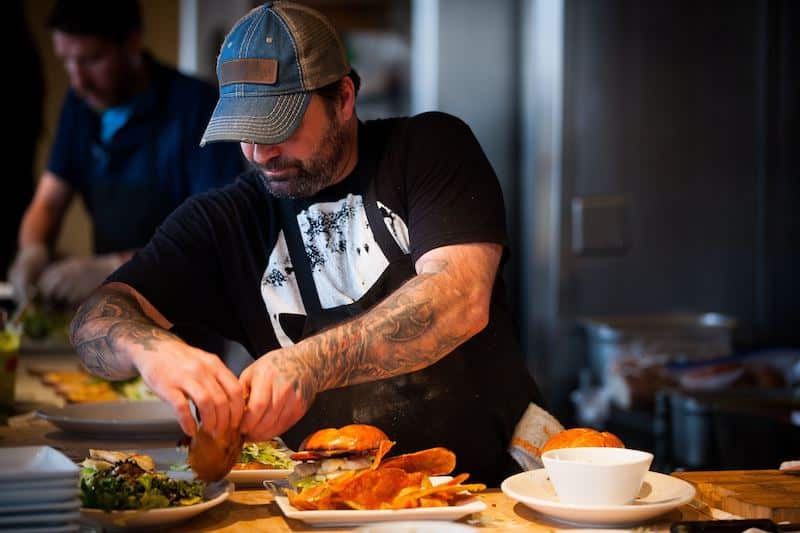
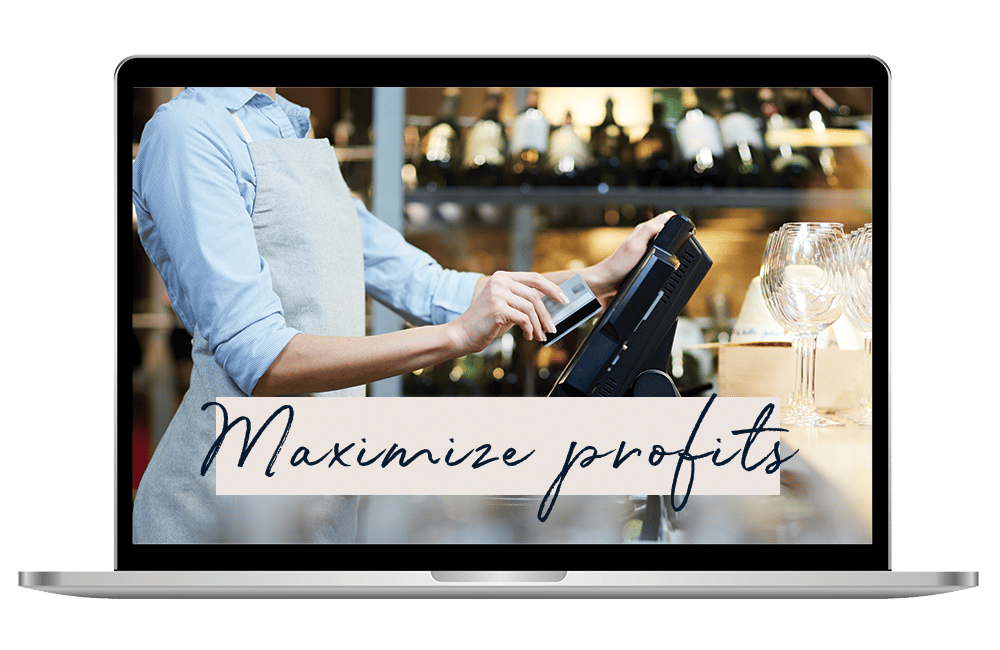
The three costly mistakes you could unknowingly be making?
Find out in this FREE guide and restaurant assessment specifically designed to reveal the unexpected hurdles standing between you and exponential business growth.
Thank You To Our Sponsors
Did You Know That 7 out of 10 Adults Dine Out To Celebrate Birthdays?
You Can Easily Capture This Lucrative Business!
For a limited time only, popmenu is offering our listeners $100 off your first month plus an unchanging lifetime rate.
Request a DEMO:
Want to become a podcast sponsor?
Please get in touch with Roger at roger@restaurantrockstars.com
